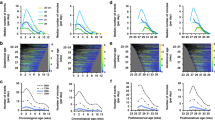Abstract
Background
Cardiopulmonary events (CPE) have a central, obstructive, or mixed etiology. Lack of standardized diagnosis and management of CPE may prolong the length of stay (LOS).
Objective
To increase the accuracy of CPE diagnosis and decrease LOS by 10% for preterm infants over a 12-month period.
Methods
Develop an evidence-based algorithm to identify type of CPE, determine management approach, and evaluate cardio-respiratory monitors output. Apply model for improvement and statistical process control charts to determine special cause variation.
Results
Identification of central apnea increased from 15 to 39% (p < 0.01). LOS decreased 26% from 52.6 days to 39.2 days, with an estimated cost savings of $13,119 per each of the 225 infants in the initiative.
Conclusion
After implementing an evidence-based algorithm for management of neonatal CPE, a significant increase in the accuracy of the diagnosis of central apnea and cost savings associated with a decrease in LOS were observed.
This is a preview of subscription content, access via your institution
Access options
Subscribe to this journal
Receive 12 print issues and online access
$259.00 per year
only $21.58 per issue
Buy this article
- Purchase on Springer Link
- Instant access to full article PDF
Prices may be subject to local taxes which are calculated during checkout


Similar content being viewed by others
References
Butler TJ, Firestone KS, Grow JL, Kantak AD. Standardizing documentation and the clinical approach to apnea of prematurity reduces length of stay, improves staff satisfaction, and decreased hospital cost. Jt Comm J Qual Patient Saf/Jt Comm Resour. 2014;40:263–9.
Erickson G, Dobson NR, Hunt CE. Immature control of breathing and apnea of prematurity: the known and unknown. J Perinatol. 2021;12:1–13.
Elder DE, Campbell AJ, Galletly D. Current definitions for neonatal apnoea: are they evidence based? J Paediatr Child Health. 2013;49:E388–396.
Zhao J, Gonzalez F, Mu D. Apnea of prematurity: from cause to treatment. Eur J Pediatr. 2011;170:1097–105.
Picone S, Bedetta M, Paolillo P. Caffeine citrate: when and for how long. A literature review. J Matern Fetal Neonatal Med. 2012;25:11–4.
Hospital discharge of the high-risk neonate—proposed guidelines. American Academy of Pediatrics. Committee on Fetus and Newborn. Pediatrics. 1998;102:411–7.
Darnall RA, Kattwinkel J, Nattie C, Robinson M. Margin of safety for discharge after apnea in preterm infants. Pediatrics. 1997;100:795–801.
Lee HC, Bennett MV, Schulman J, Gould JB, Profit J. Estimating length of stay by patient type in the neonatal intensive care unit. Am J Perinatol. 2016;33:751–7.
Eichenwald EC, Aina A, Stark AR. Apnea frequently persists beyond term gestation in infants delivered at 24 to 28 weeks. Pediatrics. 1997;100:354–9.
Newman LA, Keckley C, Petersen MC, Hamner A. Swallowing function and medical diagnoses in infants suspected of dysphagia. Pediatrics. 2001;108:E106.
Bhat RY, Rafferty GF, Hannam S, Greenough A. Acid gastroesophageal reflux in convalescent preterm infants: effect of posture and relationship to apnea. Pediatr Res. 2007;62:620–3.
Corvaglia L, Spizzichino M, Aceti A, Legnani E, Mariani E, Martini S, et al. A thickened formula does not reduce apneas related to gastroesophageal reflux in preterm infants. Neonatology. 2013;103:98–102.
Vergales BD, Paget-Brown AO, Lee H, Guin LE, Smoot TJ, Rusin CG, et al. Accurate automated apnea analysis in preterm infants. Am J Perinatol. 2014;31:157–62.
Rozich JD, Howard RJ, Justeson JM, Macken PD, Lindsay ME, Resar RK. Standardization as a mechanism to improve safety in health care. Jt Comm J Qual Saf. 2004;30:5–14.
Cullen L, Hanrahan K, Farrington M, DeBerg J, Tucker S, Kleiber C. Evidence-based practice in action: Comprehensive strategies, tools, and tips from the University of Iowa Hospitals and Clinics. Indianapolis, IN: Sigma Theta Tau Internation; 2018.
Harris PA, Taylor R, Thielke R, Payne J, Gonzalez N, Conde JG. Research electronic data capture (REDCap)—a metadata-driven methodology and workflow process for providing translational research informatics support. J Biomed Inform. 2009;42:377–81.
Author information
Authors and Affiliations
Contributions
JH helped conceptualize and design the study, played a key role in implementation, data collection and analyses, drafted the initial paper, and reviewed and revised the paper. TL played a key role in the Q.I. design and analysis of the data, assisted in the implementation, and reviewed and revised the paper. JC helped with all the statistical analyses and reviewed and revised the paper. MR conceptualized and helped design the study, assisted in the implementation, and critically reviewed and revised the paper. All authors approved the final paper as submitted and agree to be accountable for all aspects of the work.
Corresponding author
Ethics declarations
Competing interests
The authors declare no competing interests.
Additional information
Publisher’s note Springer Nature remains neutral with regard to jurisdictional claims in published maps and institutional affiliations.
Rights and permissions
About this article
Cite this article
Holman, J.L.N., Lambeth, T.M., Check, J.F. et al. Diagnosis and management of cardiopulmonary events in very low birth weight infants close to discharge: a quality improvement initiative. J Perinatol 42, 803–808 (2022). https://doi.org/10.1038/s41372-022-01367-9
Received:
Revised:
Accepted:
Published:
Issue Date:
DOI: https://doi.org/10.1038/s41372-022-01367-9



